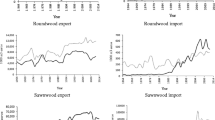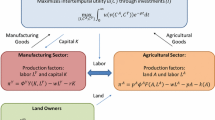Abstract
Computable general equilibrium (CGE) models are extensively used to simulate the economic impact of forest policies. In this study, we conduct a counterfactual analysis to assess the impact of an export tax ranging from 5 to 20% on the plywood sector to the Indonesian economy. The indonesian economy is aggregated into 5 sectors: 2 sectors are related to forest,i.e., (1) log, and (2) plywood. The other three sectors are not related to forest,i.e., (3) non-wood manufacturing, (4) agriculture, quarrying, and services, and (5) construction. The simulation results show that an export tax on the plywood processing sector is negatively correlated with real GDP and labor demand in log and plywood sectors, but is positively correlated with total labor demand, government revenue, income distribution, wood resources and social welfare. Reduction in labor demand by log and plywood sectors, due to a plywood export tax, can be absorbed in other sectors. The simulated policy of an export tax on plywood can reserve trees in production forests for future use.
Similar content being viewed by others
Literature cited
Alavalapati, J.R.R., Percy, M.B., and Luckert, M.K. (1997) A computable general equilibrium analysis of a stumpage price increase policy in British Columbia. J. For. Econ. 3: 143–169.
Alavalapati, J.R.R., Adamowicz, W.L., and White, W.A. (1999) Random variables in forest policy: A systematic sensitivity analysis using CGE models. J. For. Econ. 5: 321–335.
Barbier, E., Aylward, B., Burgess, J.C., and Bishop, J. (1994) The economics of the tropical timber trade. 179pp, Earthscan Publications, London.
Binkley, C.S., Percy, M.B., Thompson, W.A., and Vertinsky, L. (1994) A general equilibrium analysis of the economic impact of a reduction in harvest levels in British Columbia. For. Chron. 70: 449–454.
Biro Pusat Statistik Indonesia (1990a) Table input-output 1990. Jakarta.
Biro Pusat Statistik Indonesia (1990b) Social accounting matrix, 1990. Jakarta.
Ezaki, M. (1986) A CGE model of the Japanese economy. Research Institute for Economic and Business Administration, Kobe University, Kobe.
Fenton, R. (1996) The Indonesian plywood industry. 105pp, Institute of Southeast Asian Studies, Singapore.
Jakfar, F. and Murashima, Y. (1999) Development of the timber industry and timber trade in Indonesia. J. For. Econ. 45: 9–15.
Repetto, R. and Gillis, M. (1988) Public policies and the misuse of forest resource. 432pp, Cambridge University Press, New York.
Shoven, J.B. and Whalley, J. (1984) Applied general equilibrium model of taxation and international trade: An introduction and survey. J. Econ. Lit. 22: 1007–1051.
Takeuchi, K. (1983) Mechanical processing of tropical hardwood in developing countries: Issues and prospects for the plywood industry’s development in the Asia Pacific Region, in the case studies on industrial processing of primary products. World Bank Vol. 1. World Bank, Washington, D.C.
Author information
Authors and Affiliations
About this article
Cite this article
Jakfar, F. A general equilibrium analysis of the economic aspects of the imposition of an export tax on the plywood sector in Indonesia. J For Res 6, 73–80 (2001). https://doi.org/10.1007/BF02762491
Accepted:
Issue Date:
DOI: https://doi.org/10.1007/BF02762491




